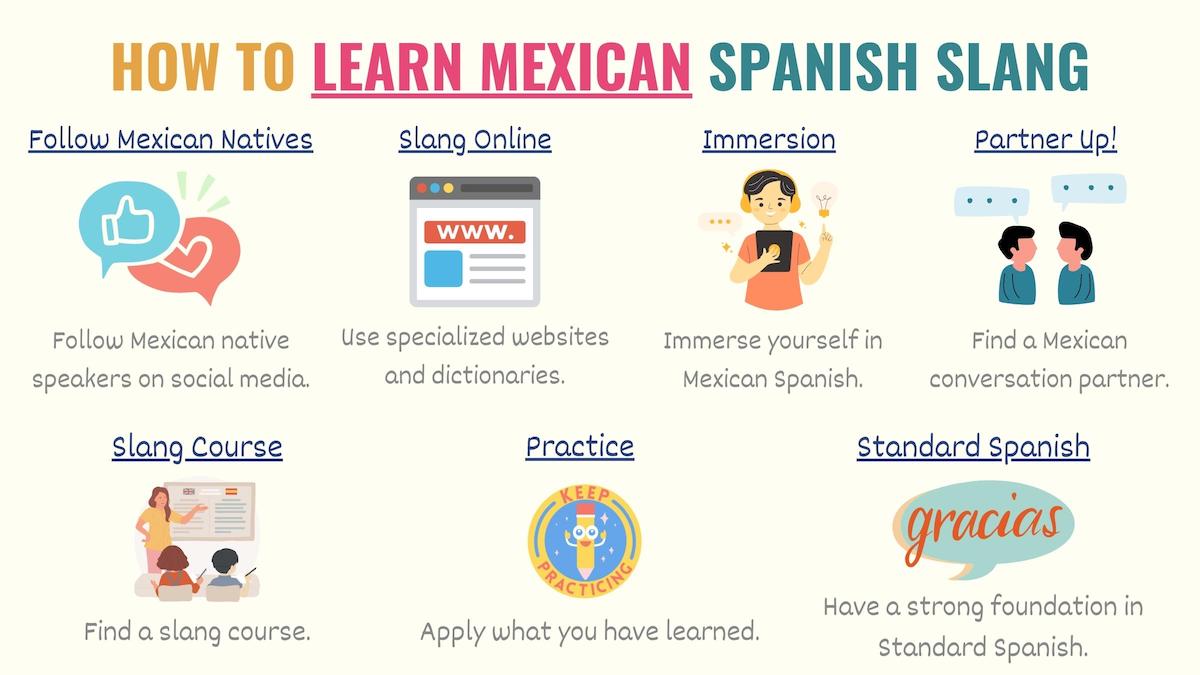It’s well known that Mexico has the biggest number of Spanish speakers in the world! If you already realized this and you’re focusing on this Spanish dialect, you should invest some time into learning Mexican slang.
Many courses overlook the importance of idioms and colloquialisms, to solely focus on teaching you formal and standard Spanish. However, if you’re planning to travel or live in Mexico for a while, knowing some Mexican slang words and phrases can help you communicate more naturally and effectively.
Since this vocabulary can help you improve your conversations, here are the topics that we’ll cover in this guide:
- What Is Mexican Slang and Why You Need It
- Tips to Learn Mexican Colloquial Vocabulary
- List of Mexican Informal Words & Phrases
- Next Steps: Top Resources for Mexican Spanish
Mexican Slang: What Is Slang and Why Do You Need It?
When it comes to language and communication, slang refers to a set of informal words and expressions used by a group of people. In other words, we Mexican speakers have a long list of terms and phrases that exist or whose meaning is only applicable within our culture.
Because of its informal nature, this vocabulary is more commonly used in casual settings, such as posting on social media, texting, or talking to your friends.
Although it can only be applied in informal contexts, Mexican colloquialisms are crucial for daily conversations.
So, now that you know what slang is, why should you learn it? As a Mexican speaker, I can tell you that there are certain ideas and feelings that you convey more effectively when using a slang term or expression.
If you’re still wondering if learning this type of Mexican vocabulary is useful, a language research study conducted by Lancaster University concluded that language learners need to be able to understand colloquial expressions. This is because if you ignore these elements, you’ll struggle to communicate in all the different contexts that native speakers do.
Get a Step-by-Step Map to Learning Spanish
Join the Tell Me In Spanish community and get a copy of my step-by-step Spanish Learner’s Roadmaps and tricky synonyms & vocab cheat sheets.
A real-life example: when I taught Spanish to foreigners in a classroom, most of my students could speak and understand most of what we talked about. However, when interacting with Mexican people in daily situations, most of them couldn’t understand a single word. The issue? They didn’t know the basic informal terms Mexicans were using.
Below you’ll find some real advantages of incorporating Mexican slang into your conversations:
- Communicate your ideas more clearly and effectively.
- Improve your command and fluency of Mexican Spanish.
- Learn highly common terms and expressions that you’ll actually use.
- Have the ability to communicate in daily conversations.
- Gain a better understanding of Mexican culture.
- Understand nuances of Mexican Spanish and prevent misunderstandings.
How to Learn Mexican Spanish Slang

Unlike standard Spanish, many learners are unsure of what to do to learn Mexican slang words. Here are some actionable tips you follow:
- Follow Mexican native speakers on social media. As mentioned above, slang is a common language tool in social media. As a result, you want to follow Mexican influencers, so you may be more in touch with this language. You can also follow social media groups or pages that focus on Mexican language and culture.
- Use specialized websites and dictionaries. As its name suggests, La Academia Mexicana de la Lengua studies and promotes the Spanish Mexican dialect. If you’re serious about learning colloquial Mexican terms, use their dictionary and expressions database to incorporate new words and phrases into your vocabulary.
- Immerse yourself in Mexican Spanish. The best way to acquire new casual vocabulary is by watching others using this type of language. To do so, you should watch Mexican movies, TV shows, or YouTube videos.
- Find a slang course. Even though you may not learn slang at school, there are a few courses that actually focus on teaching you colloquial Spanish.
- Find a Mexican conversation partner. Given that Mexican slang is more common in speech, you should try to find a Mexican conversation partner. Having constant conversations with a native speaker can definitely help you increase and practice this new skill. Additionally, your conversation partner may be able to address any questions and doubts you may have.
- Apply what you have learned. No matter what strategies you use, improving your Mexican slang will be difficult if you don’t practice and apply the things you learned. For that reason, take the time to make notes, write your own examples and try to incorporate the new phrase or slang term you learned into your conversations.
- Have a strong foundation in Standard Spanish. Since you’re learning Spanish as a second language, you want to think of Mexican slang as words and phrases which you swap out with your standard Spanish. While it’s absolutely fine to learn it on the fly as you’re learning Spanish, you’ll make the most out of each slang term and phrase you add to your vocabulary by knowing how to speak the formal language effectively.
Examples of Informal Words & Phrases Used in Mexico
As you can imagine, Mexican slang vocabulary is extensive. But to get you started, I’ve compiled a list of the most common slang terms and expressions you should know. Make sure you start incorporating it into your conversations as soon as possible.
Popular Mexican slang words
- Cantón
- Carnal & Carnala
- Chafa
- Chava & Chavo
- Chela
- Chorro
- Chula & Chulo
- Compa
- Cuate
- Gacho & Gacha
- Gandalla
- Güey
- Güera & Güero
- Mijo & Mija
- Morro & Morra
- Neta
- Órale
- Pancho
- Pichar
Take Note: A Spanish slang word cannot always be literally translated into another language. You can check other cool Mexican slang words in this guide.
Popular Mexican slang phrases
Take Note: Mexican slang phrases may not be literally translated. In many cases, a phrase is likely to have an English equivalent expression.
Mexican Slang-Related Resources
Although all Spanish speakers are able to understand each other, there are some key differences between each Spanish dialect. To understand what this means, you should check the differences between Mexican and Castilian Spanish.
If you’re unsure of what type of Spanish you want to pursue, you can start by getting familiar with standard Spanish nouns, adjectives, and verbs. Music and TV are great sources of vocabulary. Here are some easy Spanish songs you can check. You’ll learn slang words from them as well as expressions. Keep listening to the songs until you can successfully extract each slang term.

